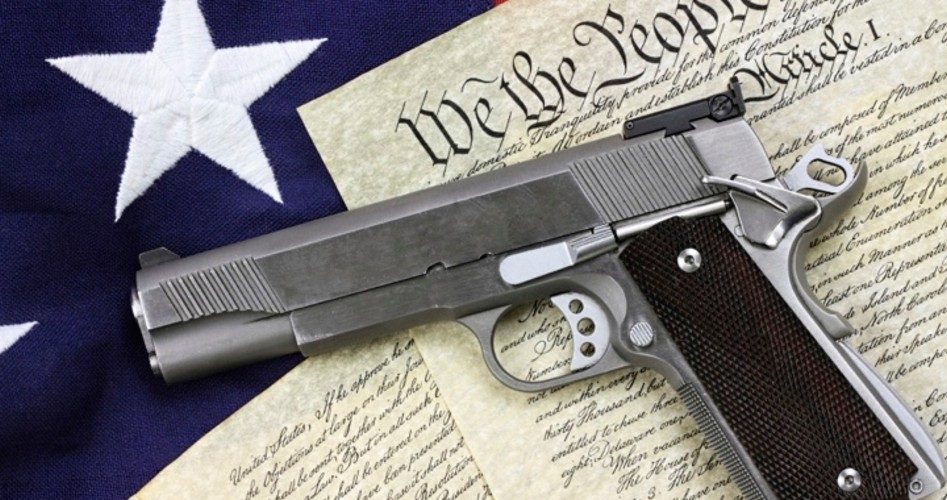
Missouri lawmakers passed a bill expanding Second Amendment-protected self-defense rights just as the legislative session was coming to a close last Friday night. The bill is now on Governor Jay Nixon’s desk awaiting his signature.
Once it becomes law, it will allow Missourians to carry concealed, if they care to, without first being forced to apply for permission to do so. The new law also enacts a “stand-your-ground” right allowing citizens to defend themselves against attack in any place where they have a right to be. This would make Missouri the 31st state in the union where those laws (or court precedents) already exist, and the first since 2011 to enact such a law.
The bill passed both state houses with more than enough votes to override a veto if Nixon decides to turn it down.
Missouri is just one more example of pro-Second Amendment victories being enjoyed by citizens across the land as momentum continues to build for such expansions.
Beginning with a concealed-carry law in 2004, Ohio has continued to pass a steady stream of pro-gun laws, with more in the pipeline. Of 25 bills dealing with firearms in the state’s present legislative session, 14 would expand gun rights, while just seven would restrict them. And most of those restricting gun rights end up never getting out of committee.
The next step in Ohio is passing House Bill 48, which would remove present restrictions against carrying concealed into university buildings, day-care centers, school zones, private aircraft, government buildings, and the public areas of airports and police stations. Opponents are calling HB 48 a “guns everywhere” bill, while supporters say it will further reduce “gun-free” zones and their attractiveness to would-be shooters seeking unarmed targets.
In recent years, Ohio has passed and then expanded the “castle doctrine” to include not only private homes but personal vehicles as well. National reciprocity with other states has been expanded, as has carrying concealed into bars and restaurants.
In Kansas, Governor Sam Brownback just signed into law a bill that allows public employees to carry concealed while going about their daily duties. This followed a law passed last year that eliminated a state requirement that a citizen applying for a permit must take an eight-hour class first. Now Kansans are free to determine if they need to take such a class, or not.
Even in Massachusetts, a state traditionally noted for its anti-Second Amendment stance, pushback at a local level ended anti-gunners’ attempts to restrict its citizens’ rights. On May 10, nearly 1,000 of Longmeadow, Massachusetts’ 15,000 residents showed up at a town meeting to protest bills that would have imposed a $300 fine for anyone carrying a gun in public or for possessing an “assault” weapon, and would have required all citizens to register their firearms with the police department. The debate extended into the wee hours of the morning before each of these intrusions was overwhelmingly voted down.
When bills are offered to restrict ownership of firearms, their proponents usually claim they will restrain criminal activity while claiming that further expansion of ownership will have dire consequences. But most of those dire consequences never happen. As Dean Rieck, executive director of the Buckeye Firearms Association, said, “Once we had Ohio citizens carrying concealed weapons, everybody discovered that the sky was not going to fall. It made a lot of other legislation significantly easier … nothing disastrous happened. We found out that people who were carrying concealed were doing so responsibly.”
As common sense regains it footing and the Second Amendment is increasingly being understood, honored, and enforced, violent gun crime continues to decline. In 2000, the national gun homicide rate was 3.8 per 100,000 people, nearly half of what it was seven years earlier. As of 2014, that number has dropped further, to 3.43 per 100,000, according to Pew Research.
Even that number is too high, as it is skewed by just a few cities (most with onerous, even draconian, restrictions on Second Amendment-protected rights) with outsized gun violence. For instance, San Francisco’s rate of gun violence per 100,000 population, according to the Independent Journal, is 6.7, Los Angeles is 9.2, Phoenix is 10.6, Houston is 12.9, Minneapolis is 7.1, Chicago is 11.4, New Orleans is 62.1, Atlanta is 17.2, Detroit is 35.9, Buffalo is 16.5, Baltimore is 29.7 and Washington, D.C., is 19.
One can hope that the common sense reflecting support for the Second Amendment might soon infiltrate these murder capitals as well.
A graduate of an Ivy League school and a former investment advisor, Bob is a regular contributor to The New American magazine and blogs frequently at LightFromTheRight.com, primarily on economics and politics. He can be reached at [email protected].



